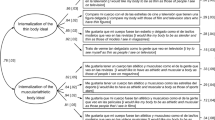Abstract
A brief measure of internalization of societal norms regarding appearance was developed and validated on six early adolescent female samples (mean ages 11.7–13.3) from three countries (US, Australia, India; total n=2210). Internal consistency levels were uniformly high in all samples, ranging from 0.83 to 0.92. Convergent validity estimates were high in all samples. Level of internalization was significantly positively correlated with levels of body dissatisfaction and restriction for all samples. Internalization was also significantly positively correlated with bulimic behaviors and negatively correlated with levels of self-esteem for the four samples that included these variables. The findings indicate that the Sociocultural Internalization of Appearance Questionnaire — Adolescents (SIAQ-A) may be used to further explore a media influence cross-culturally, allowing for the investigation of the role of internalization as a potential risk factor for body image problems and eating disturbances in different contexts.
Similar content being viewed by others
References
Stice E.: Risk factors for eating pathology: Recent advances and future directions. In: Striegel-Moore R., Smolak L. (Eds.), Eating disorders: Innovative directions in research and practice. Washington, DC, APA, 2001, pp. 51–74.
Thompson J.K., Smolak L.: Body image, eating disorders, and obesity in youth: Assessment, prevention, and treatment. Washington, DC, APA, 2001.
Thompson J.K., Stice E.: Internalization of the thinideal: A potent risk factor for body image and eating disturbances. Curr. Dir. Psychol. Sci., 10, 181–183, 2001.
Thompson J.K., Heinberg L.J., Altabe M., Tantleff-Dunn S.: Exacting beauty: Theory, assessment and treatment of body image disturbance. Washington, DC, APA, 1999.
Cusumano D.L., Thompson J.K.: Media influence and body image in 8–11 year-old boys and girls: A preliminary report on the Multidimensional Media Influence Scale. Int. J. Eat. Disord., 29, 37–44, 2001.
Smolak L., Levine M.P., Thompson J.K.: The use of the Sociocultural Attitudes Towards Appearance Questionnaire with middle school boys and girls. Int. J. Eat. Disord., 29, 216–221, 2001.
Heinberg L.J., Thompson J.K., Stormer S.: Development and validation of the Sociocultural Attitudes Towards Appearance Questionnaire. Int. J. Eat. Disord., 17, 81–89, 1995.
Anderson-Fye, Becker: Cross-cultural aspects of eating disorders. In: Thompson J.K. (Ed.), Handbook of eating disorders and obesity. New York, Wiley, 2004, pp. 565–589.
Van den Berg P., Wertheim E., Thompson J.K., Paxton S.J.: Development of body image, eating disturbance, and general psychological functioning in Australian adolescents: A replication using covariance structure modeling. Int. J. Eat. Disord., 32, 46–51, 2002.
Garner D.M.: Manual for the Eating Disorder Inventory. Odessa, Fl, Psychological Assessment Resources Inc, 1991.
Rosenberg M.: Society and the Adolescent Self-Image. Princeton, NJ, Princeton University Press, 1965.
Demo D.H.: The measurement of self-esteem: Re-defining our methods. J. Pers. Soc. Psychol., 48, 1450–1502, 1985.
Wylie R.C.: Measures of self-concept. Lincoln, University of Nebraska Press, 1989.
Tilgner L., Wertheim E.H., Paxton S.J.: The effect of social desirability on adolescent girls’ responses to an eating disorders prevention program. Int. J. Eat. Disord., 35, 211–216, 2004.
Crandall V.C., Crandell V.J., Katkovsky W.: A children’s social desirability questionnaire. J. Consul. Psychol., 29, 27–36, 1965.
Crandall V.C., Crandall V.J., Katkovsky W.: Children’s Social Desirability Scale (CSD). In: Robinson J., Shaver P., Wrightsman L. (Eds.), Measures of Personality and Social Psychological Attitudes. vol. 1. Academic Press, 1991, pp. 43–46.
King M., Bhugra D.: Eating disorders: lessons from a cross-cultural study. Psychol. Med., 19, 955–958, 1989.
Wertheim E., Paxton S., Blaney S.: Risk factors for body image disturbance. In: Thompson J.K. (Ed.), Handbook of eating disorders and obesity. New York, Wiley, 2004, pp. 463–494.
Stice E., Hoffman E.: Prevention of eating disorders. In: Thompson J.K. (Ed.), Handbook of eating disorders and obesity. New York, John Wiley, 2004, pp. 33–57.
Author information
Authors and Affiliations
Corresponding author
Rights and permissions
About this article
Cite this article
Keery, H., Shroff, H., Thompson, J.K. et al. The Sociocultural Internalization of Appearance Questionnaire — Adolescents (SIAQ-A): Psychometric analysis and normative data for three countries. Eat Weight Disord 9, 56–61 (2004). https://doi.org/10.1007/BF03325046
Published:
Issue Date:
DOI: https://doi.org/10.1007/BF03325046




